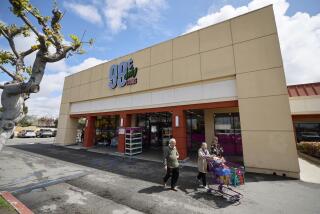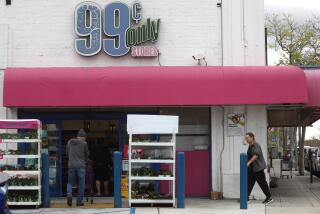Out of Bounds : Amid Golf Boom, Eastern Chain Closes O.C. Outlet
- Share via
Despite a flourishing nationwide golf retailing industry, a major golf equipment chain has closed its four Southern California stores and retreated to its home base in the East.
Industry insiders say Sunday’s shutdown of Virginia-based Washington Golf Centers shops in Santa Ana, Torrance, Los Angeles and Encino was caused by the company’s inability to manage its 5-year-old expansion effort and isn’t a warning of tough economic times ahead for the industry.
But it does underscore the competitiveness of a fast-growing retail golf market that, like the video rental business in the 1980s, is consolidating as competition from strong operators winnows out the weaker ones.
The sport is picking up followers with the exposure gained from the highly publicized triumphs of Orange County golf superstar Tiger Woods. But as business booms, the big, well-financed golf equipment discounters are taking market share away from neighborhood shops.
“Some of the smaller independents can’t hold out against the big discounters” who recently have begun adding pricier name brand goods to their golf equipment offerings, said Bill Hodson, sales manager for Winn Inc., a Huntington Beach manufacturer and wholesaler of custom golf club grips.
The mix enables discounters to attract older, well-heeled golfers with a yen for prestigious equipment as well as younger players with limited budgets.
“Overall, though, I don’t see any shrinkage in the market,” said Hodson, who visits hundreds of retailers a year.
Golfers in the U.S. spent nearly $16 billion on the game in 1994--almost double the amount spent just eight years earlier, the National Golf Foundation reported recently. Retail purchases of golf equipment topped $6 billion in 1994, with greens fees and membership fees accounting for the remaining $10 billion, according to the study.
The spending has lured the unprepared into the business, says Larry Taylor, president of Rawlings Golf.
“The market is really healthy in terms of consumer demand, but it is easy to get into the retailing business. We feel that there are still too many outlets, so there will be some further closings,” said Taylor, whose Chatsworth company makes the new Rawlings line of clubs marketed through a variety of golf retail and sporting goods outlets.
Washington Golf wasn’t a victim of retailing incompetence, industry insiders say. “They are one of the best golf club retailers in the world,” insists Bruce Parker, president of Callaway Golf Co.’s sales subsidiary.
Instead, the Virginia-based retailer closed its California operation and laid off 35 employees, including nine in Santa Ana, because it found that the 3,000-mile distance from the chain’s top management hurt operations, industry insiders said.
“They’ve had a lot more problems with the California stores than the Eastern stores, including thefts of goods,” said one industry source who asked to remain unidentified.
Trying to keep four shops operating in Southern California while focusing most of the company’s energies in the East “just wasn’t worthwhile for us,” Washington Golf Vice President Joe McOwen acknowledged. The company has 10 stores in the Washington area and is the South Korea distributor for clubs made by Carlsbad-based Callaway.
*
In Southern California, the company faced competition from discount golf centers like Santa Ana-based Roger Dunn Golf Shops and Nevada’s Las Vegas Discount Golf & Tennis and from well-entrenched sporting goods chains and even big-box discount centers.
Costco, for example, now sells high-end brands of clubs, such as Callaway, that once were the exclusive purview of golf-specific retailers like Washington.
And chains like Sports Chalet and Oshman’s Sporting Goods are adding or beefing up golf sections to meet demand for clubs, clothing and other equipment.
Houston-based Oshman’s and Las Vegas Discount Golf launched a pilot program in March with a Las Vegas Discount center located inside Oshman’s Irvine retail store. “It’s working very well,” said Tom Hurford, executive vice president of the Nevada-based golf equipment retailer.
Las Vegas Golf has opened two new stores since June--one in Irvine and one in Huntington Beach, giving it a total of 45 company-owned and franchise outlets, including four in Orange County and four in Los Angeles County. Hurford said the company plans to open seven new stores by the end of the year, three of them in California.
The expansion, he said, is being funded by double-digit increases in the company’s same-store sales. The sales hikes, Hurford said, are fueled by the growing number of people playing golf.
“Half of all the golf played in the past three years was played by people over 50,” he said. “That means that the baby boomers’ families are growing up and they are finding more time for golf, and they are in their prime earning years, so they have more to spend on their equipment.”
At the other end of the spectrum, he said, the success of 21-year-old Masters champion Woods has increased the sport’s attraction to younger players and to minorities, broadening the market for golf equipment.
(BEGIN TEXT OF INFOBOX / INFOGRAPHIC)
U.S. Golf Spending
Avid golfers, although they are far fewer in number than the more casual players, purchase more than half of the $6 billion worth of golf gear sold annually in the United States. Golf-spending analysis by type of golfer:
*--*
% of % of Avg. annual golfers spending spending Avid 24 61 $1,710 Moderate 26 27 719 Occasional 50 12 183
*--*
Source: National Golf Foundation
More to Read
Inside the business of entertainment
The Wide Shot brings you news, analysis and insights on everything from streaming wars to production — and what it all means for the future.
You may occasionally receive promotional content from the Los Angeles Times.










